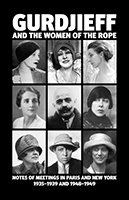Gurdjieff and the Women of the Rope
 Gurdjieff and the Women of the Rope
Gurdjieff and the Women of the Rope
Notes of Meetings in Paris and New York
1935–1939 and 1948–1949
ISBN: 978-0-9559090-6-1
Binding: Casebound
Publisher: Book Studio
Publish Date: 2012
Pages: 284
Size: 5.5″ x 8.5″
During the mid-thirties in Paris, Gurdjieff drew together four women: Solita Solano, Kathryn Hulme, Alice Rohrer, and Elizabeth Gordon—and formed a special, mutually supporting work group.
In allegory he explained: You are going on a journey under my guidance, an “inner-world journey” like a high mountain climb where you must be roped together for safety, where each must think of the others on the rope, all for one and one for all. You must, in short, help each other “as hand washes hand,” each contributing to the company according to her lights, according to her means. Only faithful hard work on yourselves will get you where I want you to go, not your wishing.
Among themselves they called their foursome “The Rope.”
The company around Gurdjieff’s table, his principal teaching site, soon expanded to include Louise Davidson, Margaret Anderson, Georgette Leblanc, and Jane Heap.
Buy from Amazon: UK | USA | Canada | France | Germany | Japan
Kindle: UK | US | CA | IN | DE | FR | ES | IT | NL | JP | BR | MX | AU | IN
Joseph Azize Reviews: Gurdjieff and the Women of the Rope
[wp_social_ninja id=”1728″ platform=”reviews”]
 Follow
Follow